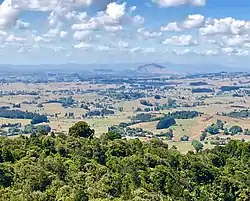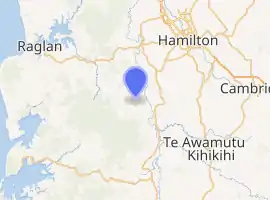Te Pahu
Te Pahu is a rural community in the Waipa District and Waikato region of New Zealand's North Island, located just north of Cambridge across State Highway 1.
Te Pahu | |
|---|---|
Village | |
 Te Pahu and Kakepuku from Karamu Walkway | |

| |
| Coordinates (,): 37.935145°S 175.172865°E | |
| Country | New Zealand |
| Region | Waikato region |
| District | Waikato District |
| Elevation | 50 m (160 ft) |
| Population (2013 census) | |
| • Territorial | 1,428 |
| Time zone | UTC+12 (NZST) |
| • Summer (DST) | UTC+13 (NZDT) |
It is located north of Pirongia and south of Ngāhinapōuri just off State Highway 39.
Karamu Walkway runs along the Kapamahunga Range to the north of the village. It is part of Te Araroa long-distance walkway.[1]
History
Early history
Descendants of the Tainui waka are the first recorded settlers of the area. They established Purakau Pā at the junction of the Kaniwhaniwha stream and the Waipa river and settled the lower valley. Mahanga's son suffered a major defeat to Kawhia Māori and Mahanga suffered a major defeat to Europeans during the Invasion of the Waikato; his land was confiscated and he was forced to relocate to the north.[2]
In 1879 peace negotiations Prime Minister Grey said Harapepe was excluded from the proposal to return Waikato lands to King Tāwhiao, even though former Minister of Native Affairs, Donald McLean, had included it in his offer of terms. A Waitangi Tribunal report says, "This was, it seems, the first official public admission that not all Crown lands were to be made available to return to the Kīngitanga. In particular, the Grey Government planned to exclude the blocks that McLean had repurchased specifically to include them in the package of lands ringfenced for return, which were mostly in the Harapepe district around Pirongia. But Grey did say that some Harapepe lands would be set aside as an endowment for a school at which Kīngitanga children could be educated."[3]
European settlement
During the war the area was settled by British militia, who were banned from leaving the area but often too poor to buy crops to continue living there. Many lots were abandoned; settlers who continued living there constantly feared attack from local Māori and often sought shelter in a blockhouse. A local industry of flax milling, and mixed cow and pig farming.[2]

Te Pahu remained extremely isolated for many years, with settlers relying on supplies delivered by the Waipa River. A pub and general store were established in the 1860s, followed by a post office in 1866 and a school house in 1877. The school house was used for monthly Presbyterian church services; it closed briefly and reopened before burning down in 1891; another school opened nearby in 1889 and took in the remaining students.[2]
A bridge was built over the river in 1881, reducing the community's isolation.[2]
The area was struck by major flooding in 1907 and February 1958, leaving the community again cut off from Te Awamutu and Hamilton.[2]
A limeworks was built on Limeworks Loop Rd in 1917.[4]
Harapepe
The name Harapepe remains on the modern map,[5] 1.2 km (0.75 mi) south of Te Pahu Road corner, though it has lost all but a few houses. It was originally the main military settlement in the area, with –
- a blockhouse (in a 1943 aerial photo it was c. 20 m (66 ft) square on a long ridge, but is now only a slight mound),
- a redoubt (built in February 1865 by the Forest Rangers, but no longer visible),[6]
- a store,
- Settlers Arms Hotel,
- Harapepe School (1877–91),[7]
- a Post Office[8] (1867–1930)[9]
The importance of Harapepe seems to have declined after Harapepe dairy was built at Te Pahu in 1897[10] and was joined in 1909[9] by neighbouring Te Pahu Post Office.[11] A daily mail service to both post offices started in 1913[12] and was taking passengers in 1914.[13] Te Pahu Hall also opened nearby in 1911.[14] The hall was renovated and extended between 1979 and 1981.[15]
As late as 1935 the name Harapepe was still being used to describe a proposed extension of electric power supplies.[16]
Harapepe is in meshblock 0860300, which had a population of 201 in 72 houses, spread over 19.6 km2 (7.6 sq mi),[17] in 2013.[18]
Modern history
In the 1920s and 1930s Robertson,[19] then Hodgson's, Motors ran a daily bus from Pirongia to Hamilton via Te Pahu.[20]
A new garage and general store was established in 1952. A limeworks opened in 1972.[2]
In 2019, Waikato Regional Council reported a surge of complaints about farm effluent discharges from farms at several Waikato locations including Te Pahu.[21]
Demographics
The Te Pahu area unit covers 158 km2 (61 sq mi),[22] centred on Te Pahu, and shows a steady growth in the population, which is wealthier than the national median -[18][23]
| Year | Population | Average age | Households | Median income | National median income |
|---|---|---|---|---|---|
| 2001 | 1110 | 33.9 | 363 | $28,000 | $18,500 |
| 2006 | 1194 | 36.2 | 411 | $29,000 | $24,100 |
| 2013 | 1269 | 41.3 | 462 | $36,500 | $27,900 |
| 2018 | 1428 | 39.1 | 507 | $40,300 | $31,800 |
In the 2018 census, there were 744 males and 684 females, giving a sex ratio of 1.09 males per female. The median age was 39.1 years (compared with 37.4 years nationally), with 318 people (22.3%) aged under 15 years, 228 (16.0%) aged 15 to 29, 735 (51.5%) aged 30 to 64, and 150 (10.5%) aged 65 or older.
Ethnicities were 91.2% European/Pākehā, 10.1% Māori, 1.3% Pacific peoples, 2.3% Asian, and 4.4% other ethnicities (totals add to more than 100% since people could identify with multiple ethnicities).
The proportion of people born overseas was 15.1%, compared with 27.1% nationally.
Although some people objected to giving their religion, 56.1% had no religion, 32.8% were Christian, 0.0% were Hindu, 0.0% were Muslim, 0.2% were Buddhist and 2.3% had other religions.
Of those at least 15 years old, 270 (24.3%) people had a bachelor or higher degree, and 165 (14.9%) people had no formal qualifications. The median income was $40,300, compared with $31,800 nationally. The employment status of those at least 15 was that 633 (57.0%) people were employed full-time, 195 (17.6%) were part-time, and 33 (3.0%) were unemployed.[24]
Most of Te Pahu village is in meshblock 0860000, which had a population of 189 in 75 houses in 2013.[18]
Education
Te Pahu School is a co-educational state primary school for Year 1 to 8 students,[25] with a roll of 111 as of March 2020.[26] The school opened in 1911.[27]
Notable people
- Helen Clark, former Prime Minister of New Zealand, administrator of the UN Development Programme
See also
Toothbrush fence on Limeworks Loop Road
References
- "Karamu Walkway". www.doc.govt.nz. Retrieved 16 March 2020.
- Clark, N (1986). "Te Pahu School 75th Jubilee Book". tepahu.co.nz. Te Pahu School.
- "Te Mana Whatu Ahuru Waitangi Tribunal Report 2018" (PDF).
- "THE WAIPA FARMERS' LIMECRUSHING COMPANY". paperspast.natlib.govt.nz. 2 April 1917. Retrieved 16 March 2020.
- "Harapepe, Waikato". NZ Topo Map. Retrieved 20 March 2020.
- Prickett, Nigel (May 2016). "Fortifications of the New Zealand Wars – 4. Waikato" (PDF). Department of Conservation. ISBN 978-0-478-15069-8.
- "Local History | Te Pahu Community Website". Retrieved 20 March 2020.
- "Harapepe Post Office". Te Awamutu Museum Collection Online. Retrieved 20 March 2020.
- "Post Offices | Te Pahu Community Website". Retrieved 20 March 2020.
- "Waipa Heritage Trail" (PDF). Waipa District Council. 2008. ISBN 978-0-473-14254-4.
- "CORRESPONDENCE HARAPEPE POST OFFICE. WAIKATO ARGUS". paperspast.natlib.govt.nz. 9 October 1913. Retrieved 20 March 2020.
- "MAIL NOTICES. WAIKATO ARGUS". paperspast.natlib.govt.nz. 3 November 1913. Retrieved 20 March 2020.
- "Page 3 Advertisements Column 4 WAIKATO ARGUS". paperspast.natlib.govt.nz. 25 March 1914. Retrieved 11 April 2020.
- "OPENING THE TE PAHU HALL. WAIKATO ARGUS". paperspast.natlib.govt.nz. 11 March 1911. Retrieved 20 March 2020.
- "Hall | Te Pahu Community Website". Retrieved 20 March 2020.
- "ELECTRIC SUPPLY. WAIPA POST". paperspast.natlib.govt.nz. 21 October 1935. Retrieved 20 March 2020.
- "ArcGIS Web Application". statsnz.maps.arcgis.com. Retrieved 20 March 2020.
- "2013 Census map – QuickStats about a place". archive.stats.govt.nz. Retrieved 16 March 2020.
- "Page 5 Advertisements Column 1 NEW ZEALAND HERALD". paperspast.natlib.govt.nz. 11 June 1926. Retrieved 20 March 2020.
- "Page 2 Advertisements Column 4 WAIKATO TIMES". paperspast.natlib.govt.nz. 28 August 1933. Retrieved 20 March 2020.
- "Surge of complaints over effluent discharges". The New Zealand Herald. Radio New Zealand. 15 October 2019.
- "ArcGIS Web Application". statsnz.maps.arcgis.com. Retrieved 16 March 2020.
- "2018 Census place summaries | Stats NZ". www.stats.govt.nz. Retrieved 16 March 2020.
- "Statistical area 1 dataset for 2018 Census". Statistics New Zealand. March 2020. Te Pahu (181400). 2018 Census place summary: Te Pahu
- Education Counts: Te Pahu School
- "Education Review Office Report". ero.govt.nz. Education Review Office.
- "1911-1961 : Te Pahu School jubilee, October, 1961 (collection record)". National Library. Retrieved 31 October 2020.